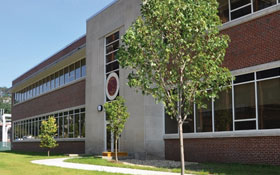Industrial Evolution: School Utilizes Factory Site for New Campus
WORCESTER, Mass. — Students at Abby Kelley Foster Charter Public High School can be forgiven if this academic year feels different from the last.
For the first time, students are participating in sports on their own fields. They lunch on fresh-cooked meals prepared in a full-service cafeteria. They perform in an auditorium and concert hall with high-definition audio-visual equipment and Internet access. They explore and experiment in new computer and science labs, and they are getting a taste of higher education in a 60-foot lecture hall.

Residents of this central Massachusetts city could also be excused if they don’t recognize what happened to 6 New Bond Street.
Just one year ago, the site of the new school was home to the dusty, dilapidated remnants of Worcester’s industrial heyday. The Norton Co. made the first grinding wheel in 1873, and it grew to become Worcester’s largest manufacturing company at the turn of the century. But as with many of New England’s aging industrial centers, the world passed it by, and the site joined a growing list of urban industrial complexes — near transit, residential and commercial areas and the urban core — ripe for redevelopment.
Now, hallways once teaming with engineers are replaced with bright-eyed young students. In place of hulking industrial equipment, rows of lockers, neatly arranged desks and rooms full of computers and laboratory stations fill interior spaces. A formal industrial yard was replaced with modern turf athletic fields.
Officials at the school spent two years searching for a potential site before settling on the Norton Co. property. The $17 million project took nearly two years from initial planning and design to construction and completion, and it came in on time and on budget.
Industrial sites are not often considered a serious option for school buildings, but with the right analysis, planning, collaboration and execution, they offer a tremendous opportunity to create value and improve the community.
The main building was in many ways already structurally ideal to serve as a school, replete with open space and a large hangar that could be converted into a new gymnasium.
The cost per square foot at Abby Kelley was significantly less than the current standard school cost set by the Massachusetts School Building Authority. This savings — much of it due to planning with existing infrastructure — enabled the school to offer additional amenities, including Bluetooth smart boards and improved lab and arts equipment. A bond offering through the Massachusetts Development Finance Agency and TD Bank provided financing.
Although teachers are still getting used to the advanced technology, they note the difference. Writing classes show student work on screens that simultaneously appear on individual computers. Music theory classes use new audio technology to deconstruct a concert performance to show the performer’s unedited voice. History classes view countries from all over the world courtesy of Google Maps.
However, despite the benefits of building on an industrial site, there are serious challenges that must be addressed. Contamination is often a concern, as many industrial properties contain pollutants and other toxic remnants of their past lives. Careful site analysis is critical, and an experienced team of project managers and design and construction professionals is essential.
The property at the Abby Kelley site required extensive remediation, including the removal of large amounts of soil, several underground chemical storage tanks and large amounts of lead left by a former recreational firing range. Vandals also exposed asbestos when trying to steal copper piping.
Because of the often complicated nature of industrial sites, the development team must also be able to plan effectively and think creatively to solve unanticipated site issues.
For example, designers envisioned a gymnasium with an open ceiling to showcase natural architecture highlighted by beautiful beams. However, that plan was abandoned after the discovery of calcimine paint, which prevented new paint from sticking to the beams. A ceiling was ultimately constructed to solve the problem.
A significant Asian longhorn beetle infestation that resulted in the removal of all vegetation also required quick thinking and planning,
Despite these types of challenges, with the right planning and analysis, select industrial sites can make outstanding schools. Forgotten for years, this former factory is once again filled with activity.
Jack Hobbs is president and CEO of RF Walsh Collaborative Partners in Boston.
